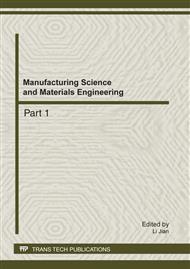[1]
Pordesimo, L.O., W.C. Edens, and S. Sokhansanj. 2004. Distribution of aboveground biomass in corn stover. Biomass and Bioenergy 26: 337-343.
DOI: 10.1016/s0961-9534(03)00124-7
Google Scholar
[2]
Carol L. Jones, Marvin L. Stone . 2004. An ASABE Meeting Presentation.
Google Scholar
[3]
Reese, G.A., R.L. Bayn, and N.E. West. 1980. Evaluation of double-sampling estimators of subalpine herbage production Journal of Range Management 33: 300-306.
DOI: 10.2307/3898079
Google Scholar
[4]
Arsar, G., L. Hipps, and E.T. Kanemasu. 1984. Assessing solar energy and water use efficiencies in winter wheat: A case study. Agric. For. Meteorol. 31 (1984): 47-58.
DOI: 10.1016/0168-1923(84)90005-4
Google Scholar
[5]
Trabelsi, S., and S. Nelson. 2003. Free-space measurement of dielectric properties of cereal grain and oilseed at microwave frequencies. Measurement Science and Technology 14: 589-600.
DOI: 10.1088/0957-0233/14/5/308
Google Scholar
[6]
Von Hippel, A. R. 1954. Dielectric Properties and Applications. New York: John Wiley and Sons.
Google Scholar
[7]
Guo,W., Nelson S.O., Trabelsi,S., &Kays S.J. (2007a). 10-1800-MHz dielectric properties of fresh apples during storage. Journal of Food Engineering. 83(4), 562-569.
DOI: 10.1016/j.jfoodeng.2007.04.009
Google Scholar
[8]
Bauchot, A.D., Harker F.R., Arnold W.M., 2000. The use of electrical impedance spectroscopy to assess the physiological condition of kiwifruit. Post harvest Biology and Technology 18(1), 9–18.
DOI: 10.1016/s0925-5214(99)00056-3
Google Scholar
[9]
Steinmetz, S., M. Guerif, R. Delecolle, and F. Baret. 1990. Spectral estimates of the absorbed photosynthetically active radiation and light-use efficiency of a winter wheat crop subjected to nitrogen and water deficiencies. Int. J. Remote Sens. 11 (1990).
DOI: 10.1080/01431169008955130
Google Scholar
[10]
Sacilik, K., R. Ozturk, R and R. Keskin. 2003. Some physical properties of hemp seed. Biosystems Engineering. 86(2). 191-198.
DOI: 10.1016/s1537-5110(03)00130-2
Google Scholar
[11]
Fechant, C. 1996. Realisation d'un quadripole de mesure in situ de la permittivite dielectrique des vegetaux. Premiere application a la determination du contenu en eau des epis de ble, Universite de Paris VI.
Google Scholar


